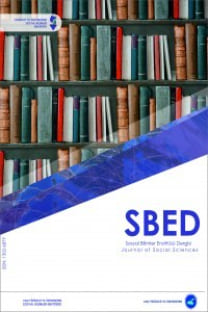Atlas’ın Yükü Adlı Eserinde Hileci Yazar Jeanette Winterson
Hileci, İsviçreli psikiyatr Carl Gustav Jung tarafından ilk kez ortaya atılan arketip kavramının önde gelen örneklerinden biridir ve genel olarak bireylerin karakterlerindeki bayağı özellikler olarak tanımlanır. Bununla birlikte çağdaş edebiyatta hileci arketipi; kurnaz, doğruyu söyleyen, hikâye anlatıcısı ve evrenin yasalarıyla oynayan bir dönüştürücü olarak tanımlanmaktadır. Hileci figür, gerçeği körü körüne kabul etmeyi reddeder; modası geçmiş zihniyetin yeri geldiğinde yıkılması gerektiği görüşünü savunur. Yıkıcı tutumuna rağmen kültürlerin tasarımına katkısından dolayı saygı duyulur. Jeanette Winterson’ın Atlas ve Herakles mitini tekrar kaleme aldığı Weight (Atlas’ın Yükü) adlı eseri, 2005 yılında farklı kültürlere ait mitleri tanınmış yazarlara yeniden yazdıran Canongate Myth Series projesi kapsamında yayınlandı. İngiliz edebiyatının önde gelen yazarlarından biri olan Winterson; titizlikle yazdığı hibrit kurgusunda, epik gelenekleri çeşitli edebi araçlar ve farklı türlerin karışımı ile yapı bozuma uğratır. Yazar, çok katmanlı eserinde gerçekte kendisini özdeşleştirdiği mitolojik kahraman Atlas üzerinden hikâyesini anlatır. Bu çalışma, eski miti yeniden kaleme alma sürecinde, kurnaz ve bilge bir dönüştürücü ve öykü anlatıcısı olarak Jeanette Winterson'ın hileci-sanatçı yönüne dikkat çekmeyi amaçlamaktadır.
Anahtar Kelimeler:
Jeanette Winterson, Atlas’ın Yükü, Hileci Yazar, Mitler, Hikâye Anlatma
Jeanette Winterson as the Trickster-Artist in Weight
The trickster is one of the outstanding examples of the concept of archetype introduced by Swiss psychiatrist Carl Gustav Jung and is described as the collection of whole inferior features in the individuals' characters. However, in contemporary literature, the trickster archetype is described as a cunning figure, a truth-teller, a storyteller, and a transformer who plays with the laws of the universe. The trickster figure rejects accepting the truth blindly; defends demolition of outdated mentality when needed. Despite his/her destructive attitude, he/she is respected for the contribution to the design of cultures. Jeanette Winterson's Weight, the retelling of Atlas and Heracles' myth, was published in 2005 within the project of The Canongate Myth Series, which commissioned prominent authors to rewrite the myths of different cultures. Winterson, one of the preeminent authors of British literature, in her meticulously written hybrid fiction, deconstructs epic traditions through various literary devices and offers a blend of different genres. In her multi-layered work, the author tells her story through the mythological hero Atlas, with whom she identifies herself. This study aims to highlight the trickster-artist facet of Jeanette Winterson as a cunning and wise transformer and storyteller in the process of rewriting the ancient myth.
Keywords:
Jeanette Winterson, Weight, the Trickster-artist, Myths, Story-telling,
___
- Bakhtin, M.M. (1981). The Dialogic Imagination. Four Essays. Emerson, C., Holquist, M. (Transl.). Austin: University of Texas Press.
- Hutcheon, L. (1985). A Theory of Parody. The Teachings of Twentieth-Century Art Form. London and New York: Methuen.
- Hutcheon, L. (1989). The Politics of Postmodernism. London: Routledge.
- Hyde, L. (1998). Trickster Makes This World. Mischief, Myth, and Art. New York: North Point Press.
- Janković, J. (2008). Let Tell The Story From The Beginning’ About the stage cantata Atlas by Anja Đorđević. New Sound: 12, 200-209.
- Jorgensen, M. H. (2005). Empty Space and Points of Light: The Self, Time, Sex, and Gender in
- Selected Works by Jeanette Winterson. Copenhagen: Museum Tusculanum P.
- Jung, C.G. (1980). The Collected Works of C.G. Jung. Princeton: Princeton University Press.
- Sartre, J. P. (1993). Essays in Existentialism. Baskin, W., Wahl, J. (Transl.). London: Citadel Press.
- Staels, H. (2009). The Penelopiad and Weight: Contemporary Parodic and Burlesque Transformations
- of Classical Myths. College Literature, 36 (4), 100-118.
- Sutton, D.F. (1980). The Greek Satyr Play. Meisenheim am Glan: Verlag Anton Hain.
- Winterson, J. (2005). Weight. Edinburgh: Canongate Books.
- ISSN: 1302-6879
- Başlangıç: 2000
- Yayıncı: Yüzüncü Yıl Üniversitesi Sosyal Bilimler Enstitüsü Müdürlüğü
Sayıdaki Diğer Makaleler
Teolojinin Evrimi veya Felsefenin Teolojiyle İmtihanı -Yöntemsel Açıdan Bir Değerlendirme-
Atlas’ın Yükü Adlı Eserinde Hileci Yazar Jeanette Winterson
Millî Mücadele Dönemi’nde (1918-1923) Güneydoğu Anadolu’da Kadınlar
Ulusal Basında Siirt İli: Cumhuriyet Gazetesi Örneği (1930-1960)
Selin GENCTURK, Yücel ÖZTÜRKOĞLU
